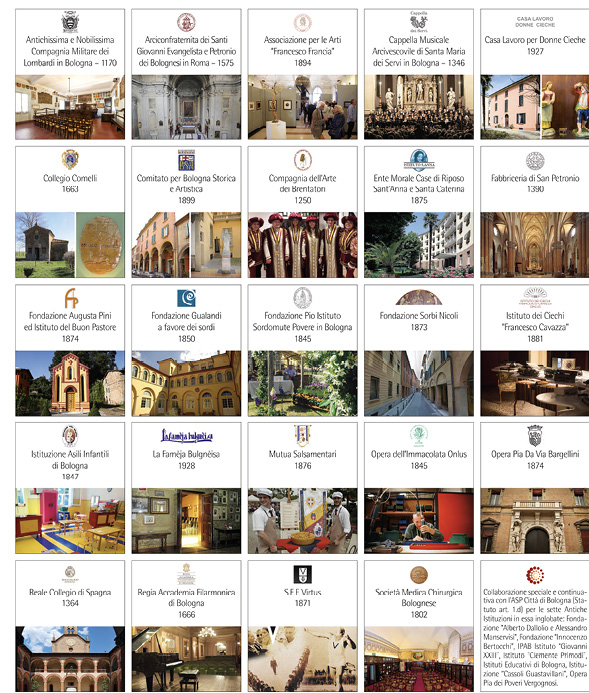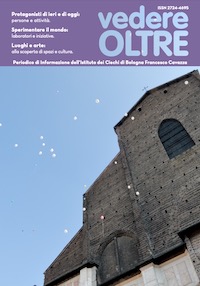Today, more and more people are hearing about the Consortium of Bologna’s Ancient Institutions and quite a few are wondering what it stands for and what its purpose is. We will try to address their justified interest. The Consortium of Bologna’s Ancient Institutions came about in 2004 as a result of a proposal by lawyer Stefano Graziosi and notary Guglielmo Franchi Scarselli. The idea is that of a group of administrators of institutions that have for centuries brought prestige to the city of Bologna, working for the benefit of Bologna’s citizens. The member institutions are characterized as follows:
–established in the Bologna area;
–operating as a non-profit organization;
–carrying out still today their institutional activities;
–having secular origin and organization, even if religiously inspired;
–having been established for at least 60 years.
The institutional purposes of the Consortium can be summarized as follows:
–to establish a network of organizations whose purposes may vary, but have over time fostered initiatives for people in difficult conditions, and for the cultural growth of the citizens of Bologna while actively promoting the historical continuity of the city;
–to collaborate in the enhancement of historical and cultural heritages and the preservation of the institutions’ traditions that have brought prestige to the city of Bologna over the centuries;
–to make available to scholars and the public their important artistic and archival heritages for preservation purposes.
The composition of the Consortium of Bologna’s Ancient Institutions has increased over the years. Twenty-five institutions currently belong to it, born in the period between the 12th and 20th centuries. From the oldest, the Antichissima e Nobilissima Compagnia Militare dei Lombardi in Bologna, founded in 1170, to the youngest, La Famèja Bulgnèisa, from 1928. These are joined by two additional institutions that have a special and ongoing collaboration with the Consortium. The priority activities carried out are numerous and varied. For the preservation of the Bolognese artistic tradition:
–the Associazione per le Arti Francesco Francia (1894), in the field of fine arts;
–the Cappella Musicale Arcivescovile di Santa Maria dei Servi in Bologna (1346) and the Regia Accademia Filarmonica di Bologna (1666), in the field of music;
–the Comitato per Bologna Storica e Artistica (1899), in the field of architecture;
–the S. E. F. Virtus (1871), in the field of sports, carrying successfully the name of Bologna high in the world for 150 years.
Many institutions came into existence largely in the second half of the 19th century to make up for serious public shortages, dedicated to assisting vulnerable people in need. Prominent among them is the Istituto dei Ciechi Francesco Cavazza whose reputation has long crossed national borders. Institutions aimed at assistance and social integration belong to this group:
–for blind and visually impaired people, the Istituto dei Ciechi Francesco Cavazza (1881) and the Casa Famiglia di Lavoro per Donne Cieche (1927);
–for people living with hearing loss, the Fondazione Pio Istituto Sordomute Povere (1845) and the Fondazione Gualandi a Favore dei Sordi (1850);
–for people living with developmental disabilities, the Opera dell’Immacolata (1845);
–for youth living in marginalized and vulnerable conditions, the Collegio Comelli (1663) and the Opera Pia da Via Bargellini (1874);
–for children, the Istituzione Asili Infantili di Bologna (1847), the Fondazione Sorbi Nicoli (1873) and the Fondazione Augusta Pini e Istituto del Buon Pastore (1874);
–and for older adults, the Ente Morale Istituto Case di Riposo Sant’Anna e Santa Caterina (1875).
Several institutions act as the guardians of Bolognese culture and traditions, namely, beginning with the oldest:
- the Antichissima e Nobilissima Compagnia Militare dei Lombardi in Bologna (1170),
–the Compagnia dell’Arte dei Brentatori in Bologna (1250),
- the Reale Collegio di Spagna (1364),
–the Fabbriceria di San Petronio (1389),
- the Arciconfraternita dei Santi Giovanni Evangelista e Petronio dei Bolognesi in Roma (1575),
- the Società Medica Chirurgica Bolognese (1802),
–the Mutua Salsamentari (1876),
- the Unione Campanari Bolognesi (1912),
–and the Famèja Bulgnèisa (1928).

Finally, it should be mentioned that the Consortium of Bologna’s Ancient Institutions maintains a special and continuous collaboration with the Accademia Italiana della Cucina (Bologna Delegation) (1956) and with the ASP Città di Bologna, for the seven institutions it incorporates: the Fondazione Alberto Dallolio e Alessandro Manservisi, the Fondazione Innocenzo Bertocchi, the IPAB Istituto Giovanni XXIII, the Istituto Clemente Primodì, the Istituti Educativi di Bologna, the Istituzione Cassoli Guastavillani and the Opera Pia dei Poveri Vergognosi.
To conclude this brief presentation about the Consortium, I think it fully captures the significance of what His Eminence Cardinal Archbishop of our city Matteo Maria Zuppi reminded us in a meeting. That is, the phrase said by the famous composer Gustav Mahler to remind us of the importance of tradition in the development of cultural modernity: “The tradition is not the worship of ashes, but the preservation of fire.”





.png)